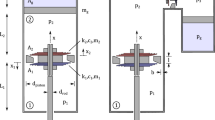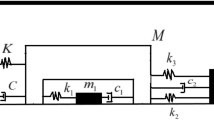Abstract
Multibody system simulation has become a mature analysis tool as part of industrial suspension design processes. However, when applied to a specific problem, it turns out that not kinematics or elasto-kinematics is the major issue, but force elements like shock absorbers. Classical linear or nonlinear characteristics are no longer applicable to modern stroke- or frequency-dependent shock absorbers, especially regarding transient, non-stationary analyses. Therefore, more emphasis has to be put on understanding and modeling this kind of elements. The paper will show a systematic modeling and identification process for a stroke-dependent, single tube shock absorber starting from basic physics laws for gas dynamics and hydraulics. Valve characteristics being the determining element of damper performance are modeled by rather flexible Hermite splines which are identified on a test rig in a two-step procedure. Simulations of VDA (Association of German Automotive Industry) tests and randomly excited vibrations of the identified damper model show high agreement with experimental results, and thus the high potential of the proposed modeling approach.









Similar content being viewed by others
References
Ajala, O., Bestle, D., Rauh, J., Rieger, K.-J.: Two-degree-of-freedom control approach for an active suspension system. In: Eberhard, P., Ziegler, P. (eds.) Proc. of IMSD 2012—2nd Int. Conf. on Multibody System Dynamics, Stuttgart (2012)
Ajala, O., Bestle, D., Rauh, J., Ammon, D.: Zero-phase filtering control of an active suspension system with preview. In: Proc. of 11th Int. Symp. on Advanced Vehicle Control, Seoul (2012)
Polach, P., Hajzman, M.: Design of characteristics of air-pressure-controlled hydraulic shock absorbers in an intercity bus. Multibody Syst. Dyn. 46, 73–90 (2008)
Rakheja, S., Su, H., Sankar, T.S.: Analysis of a passive sequential hydraulic damper for vehicle suspension. Veh. Syst. Dyn. 19, 289–312 (1990)
Scheibe, F., Smith, M.C.: Analytical solutions for optimal ride comfort and tyre grip for passive vehicle suspensions. Veh. Syst. Dyn. 47, 1229–1252 (2009)
Michalski, R., Tietke, M., Krüger, G., Scheyhing, F., Steller, G., Klingel, R.: Fahrwerk – Neudefinition der Synthese von Komfort und Agilität. ATZ, Sonderausgabe 4, 82–101 (2007)
Bestle, D., Funke, T.: Physically motivated modeling and identification of advanced vehicle shock absorbers. In: Eberhard, P., Ziegler, P. (eds.) Proc. of IMSD 2012—2nd Int. Conf. on Multibody System Dynamics, Stuttgart (2012)
Djukic, D., Bestle, D.: Optimization of damping characteristics for improved vehicle ride and handling. In: Proc. of 19th Int. Conference on Computer Methods in Mechanics, Warsaw (2011)
VDA – Verband der Automobilindustrie. URL: http://www.vda.de/en/index.html
Reimpell, J., Stoll, H.: Fahrwerkstechnik – Stoß- und Schwingungsdämpfer. Vogel, Würzburg (1989)
Duym, S.: Simulation tools, modelling and identification for an automotive shock absorber in the context of vehicle dynamics. Veh. Syst. Dyn. 33, 261–285 (2000)
Funke, T., Bestle, D.: Entwicklung eines physikalischen Dämpfermodells zur Analyse und Optimierung des Fahrverhaltens. In: Gühmann, C., Wolter, T.-M. (eds.) Simulation und Test für die Automobilelektronik III, pp. 415–427. Expert Verlag, Berlin (2010)
MATLAB—Language of Technical Computing, Version R2009b, User Guide—Mathematics. MathWorks (2009)
Gill, P.E., Murray, W., Wright, M.H.: Practical Optimization. Academic Press, London (1981)
Fritsch, F.N., Carlson, R.E.: Monotone piecewise cubic interpolation. SIAM J. Numer. Anal. 17, 238–246 (1980)
MATLAB Optimization Toolbox, User’s Guide. Natick, MathWorks (2008)
Schiehlen, W. (ed.): Multibody Systems Handbook. Springer, Berlin (1990)
Author information
Authors and Affiliations
Corresponding author
Rights and permissions
About this article
Cite this article
Funke, T., Bestle, D. Physics-based model of a stroke-dependent shock absorber. Multibody Syst Dyn 30, 221–232 (2013). https://doi.org/10.1007/s11044-013-9348-9
Received:
Accepted:
Published:
Issue Date:
DOI: https://doi.org/10.1007/s11044-013-9348-9




